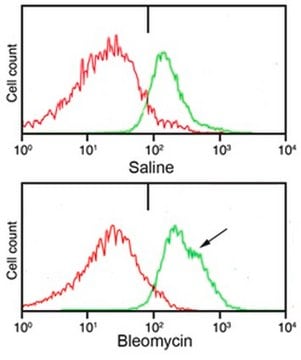MAB1912
Anti-Procollagen Type I Antibody, NT, clone M-58
culture supernatant, clone M-58, Chemicon®
Synonim(y):
Anti-Procollagen Antibody, Clone M-58 Anti-Procollagen, Type I Procollagen Detection
Zaloguj sięWyświetlanie cen organizacyjnych i kontraktowych
About This Item
Kod UNSPSC:
12352203
eCl@ss:
32160702
NACRES:
NA.41
Polecane produkty
pochodzenie biologiczne
rat
Poziom jakości
forma przeciwciała
culture supernatant
klon
M-58, monoclonal
reaktywność gatunkowa
human
spodziewany brak reakcji z
rat, hamster, mouse
producent / nazwa handlowa
Chemicon®
metody
immunohistochemistry: suitable (paraffin)
izotyp
IgG2α
numer dostępu NCBI
numer dostępu UniProt
docelowa modyfikacja potranslacyjna
unmodified
informacje o genach
human ... COL1A1(1277)
Specyficzność
Recognizes Human pro-collagen I. MAB1912 labels the amino-terminal pro-peptide.
Zastosowanie
Detect Procollagen Type I using this Anti-Procollagen Type I Antibody, N-terminus, clone M-58 validated for use in IH(P).
Immunohistochemistry: 1:10,000-1:50,000 (fresh frozen tissue sections.)
Suitable for formaldehyde/formalin fixed paraffin sections, suggested starting dilution 1:100-1:1000, after treatment with 1% trypsin, 20 minutes at room temperature. Does not stain mature collagen fibers in tissue. Localized intracellularly in cells producing pro-collagen I. Not recommended for Western Blots Optimal working dilutions must be determined by end user.
Suitable for formaldehyde/formalin fixed paraffin sections, suggested starting dilution 1:100-1:1000, after treatment with 1% trypsin, 20 minutes at room temperature. Does not stain mature collagen fibers in tissue. Localized intracellularly in cells producing pro-collagen I. Not recommended for Western Blots Optimal working dilutions must be determined by end user.
Komentarz do analizy
Control
Skin tissue
Skin tissue
Inne uwagi
Concentration: Please refer to the Certificate of Analysis for the lot-specific concentration.
Informacje prawne
CHEMICON is a registered trademark of Merck KGaA, Darmstadt, Germany
Kod klasy składowania
10 - Combustible liquids
Klasa zagrożenia wodnego (WGK)
WGK 2
Certyfikaty analizy (CoA)
Poszukaj Certyfikaty analizy (CoA), wpisując numer partii/serii produktów. Numery serii i partii można znaleźć na etykiecie produktu po słowach „seria” lub „partia”.
Masz już ten produkt?
Dokumenty związane z niedawno zakupionymi produktami zostały zamieszczone w Bibliotece dokumentów.
Kangkang Zhi et al.
Journal of experimental & clinical cancer research : CR, 29, 66-66 (2010-06-10)
The prognosis of gastric cancer patients is difficult to predict because of defects in establishing the surgical-pathological features. Cancer-associated fibroblasts (CAFs) have been found to play prominent role in promoting tumor growth, invasion and metastasis. Thus raises the hypothesis that
Procollagen 1 expression in atypical fibroxanthoma and other tumors.
Jensen, Kristin, et al.
Journal of cutaneous pathology, 31, 57-61 (2004)
Tianyuan He et al.
Age (Dordrecht, Netherlands), 36(3), 9623-9623 (2014-02-20)
Exposure to oxidants results in cellular alterations that are implicated in aging and age-associated diseases. Here, we report that brief, low-level oxidative exposure leads to long-term elevation of cellular reactive oxygen species (ROS) levels and oxidative damage in human skin
James W Reinhardt et al.
Frontiers in immunology, 12, 784401-784401 (2022-01-04)
Fibrocytes are hematopoietic-derived cells that directly contribute to tissue fibrosis by producing collagen following injury, during disease, and with aging. The lack of a fibrocyte-specific marker has led to the use of multiple strategies for identifying these cells in vivo.
Myofibroblast and endothelial cell proliferation during murine myocardial infarct repair.
Virag, JI; Murry, CE
The American Journal of Pathology null
Nasz zespół naukowców ma doświadczenie we wszystkich obszarach badań, w tym w naukach przyrodniczych, materiałoznawstwie, syntezie chemicznej, chromatografii, analityce i wielu innych dziedzinach.
Skontaktuj się z zespołem ds. pomocy technicznej







